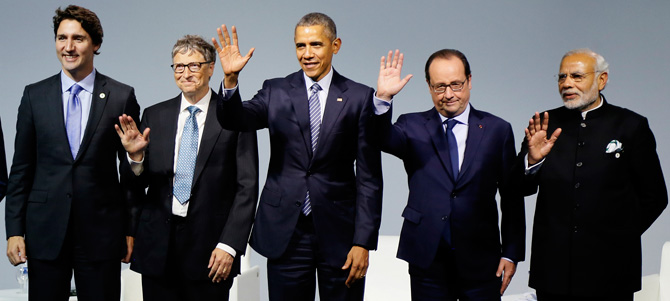When the heads of state gathered in Paris at the beginning of the climate talks last week, there was much excitement over the launch of Mission Innovation, a program to “reinvigorate and accelerate public and private global clean energy innovation with the objective to make clean energy widely affordable.”
This was a welcome step and, frankly, long overdue – total public energy R&D expenditures of the major industrialized countries are still lower than the peaks reached after the oil shocks of the 1970s.
Yet at the same time, it is symptomatic of the flawed global approach to address climate change. We move forward in some ways but sidestep the key issues – in this case, the provision of adequate and suitable support to developing countries to quickly begin a transition to low-carbon energy. The result is that we leave large gaps in our attempts to avoid dangerous climate change.
What’s not to like?
There is no doubt that elements of Mission Innovation will help broaden the pipeline of clean energy technologies in the future. This could be a great boon to climate mitigation efforts.
Measures call for:
- a doubling of public energy R&D expenditures of 20 major economies over the next five years
- working with business and private investors to commercialize resulting technologies, including the establishment of the Bill Gates-led Breakthrough Energy Coalition by a group of wealthy private investors
- effective, efficient and transparent implementation
- sharing of information about energy R&D efforts with the private sector and other relevant stakeholders.
But given the long time required for technology innovation in the energy area, it likely will be well over a decade before we see any large-scale commercial application of the technologies developed through Mission Innovation. In fact, the joint statement itself seems to acknowledge this when it talks about being part of a “long-term response to the climate challenge.”
What’s missing from the technology discussions in the climate arena is a focus on a much more important and urgent issue: how to ensure that cleaner energy technologies available today are deployed quickly and at scale in developing countries. Moving their energy systems on a lower-carbon trajectory in the short term is critical because these countries need more energy to fuel their economies and are rapidly growing their energy infrastructure.
Although the UN Framework Convention on Climate Change obliges industrialized countries to take the lead in combating climate change, they instead have invested much effort in getting developing countries to take on greater obligations.
Developing countries, for their part, have committed to undertake significant levels of climate action. These commitments were outlined before the Paris summit in their intended nationally determined contribution (INDC) submissions.
The Civil Society Review of the pledges under the INDCs, as carried out by a large group of NGOs, indicates that developing countries, with their far more limited capabilities and resources, have pledged greater absolute mitigation (about nine Gigatons of CO2 equivalents) than the industrialized countries (~6Gt CO2-eq), in relation to the emissions projected for 2030.
Developing countries, in other words, have clearly risen to the challenge of contributing to the solution to climate change in the near term.
But not so easy
But the successful achievement of their ambitious goals will require large-scale implementation of low-carbon and other technologies, such as wind, solar and energy-efficient technologies. This, in turn, requires a range of activities before any new energy systems are actually installed.
For example, countries need to analyze options to understand which technologies and pathways are best suited to their specific national contexts. They also need to devise strategies to make suitable technologies available affordably and quickly. And then they need to manage the process of introducing these technologies into local contexts and eventually scaling up their deployment.
This requires not just technical and financial resources but also new policies as well as delivery models. And the needs are different at different stages of the cycle – from technology development to commercial demonstration, market introduction, and eventually broader diffusion.
To make matters even more complex, each technology – whether it’s a solar-powered microgrids or long-distance transmission lines – has different requirements in each country.
In other words, there is no simple “one-shoe-fits-all” approach to the successful implementation of climate technologies.
Supporting the energy transition
The problem is most developing countries do not have the capabilities to undertake this implementation by themselves. They will need assistance to ensure adequate planning and the speedy and effective implementation of clean energy technologies.
A recognition of this critical need led to the establishment the Climate Technology Center and Network (CTCN) under the UN Framework Convention on Climate Change (UNFCCC), which is intended to assist developing countries with technology solutions, implementation advice and capacity building.
Yet the CTCN is woefully underresourced and has struggled to raise funds for its operation. Its budget for 2016 is a mere US$18.6 million, of which $7 million has yet to be secured, according to officials. The Climate Technology Center (the hub that coordinates the response to developing country requests) has a total staff of eight.
Incredibly, the funding for the CTCN so far has not come through the UNFCCC channels but through bilateral channels such as Norwegian and Danish governments and the European Union. This creates long-term funding uncertainty and sometimes the imposition of specific conditions. This underresourced entity is supposed to help all developing countries successfully implement their climate technology plans.
Comprehensive view needed
So here we have, on the one hand, a situation in which we are talking about additional investments of billions of dollars in energy R&D for future technological options through Mission Innovation but, on the other hand, an almost utter disregard for enhancing the effectiveness of near-term climate technology implementation.
Forgotten (or ignored) is the text from the UNFCCC that states that industrialized countries will commit “financial resources and transfer of technology” to developing countries.
There is, therefore, a real danger that developing countries will not be able to successfully implement their INDCs, which in turn further threaten our ability to meet our climate targets. (It should be noted that the sum total of the pledges under the INDCs are far from sufficient to put us on the path even to a 2 degree Celsius global mean temperature rise above preindustrial levels.)
This situation, unfortunately, is par for the course in the climate arena. Many of the real needs of developing countries are not being given sufficient attention or appropriate levels of support – climate finance and adaptation are other examples.
Instead, industrialized countries are jostling for leadership in shifting the burden of mitigation and adaptation to developing countries rather than in taking aggressive climate action themselves. And they are shying away from providing suitable resources to developing countries to address or adapt to climate change.
And much of the action is outside the UNFCCC as with Mission Innovation, not in the multilateral process, as with the Technology Mechanism of the UN. It is not an “either-or” – we need both and the former cannot substitute for the latter.
One must still hope, therefore, that the Paris agreement will pay attention to providing adequate and appropriate technical and financial support through the UN multilateral process to help developing countries implement their own pledges. Frankly, there is no other choice, not if we are serious about the climate problem.
Reference:
This article has been published here with permission by the PVBuzz Media team from the original article written by Ambuj D Sagar (Vipula and Mahesh Chaturevdi Professor of Policy Studies , The Indian Institute of Technology Delhi) and published on The Conversation.















Comments